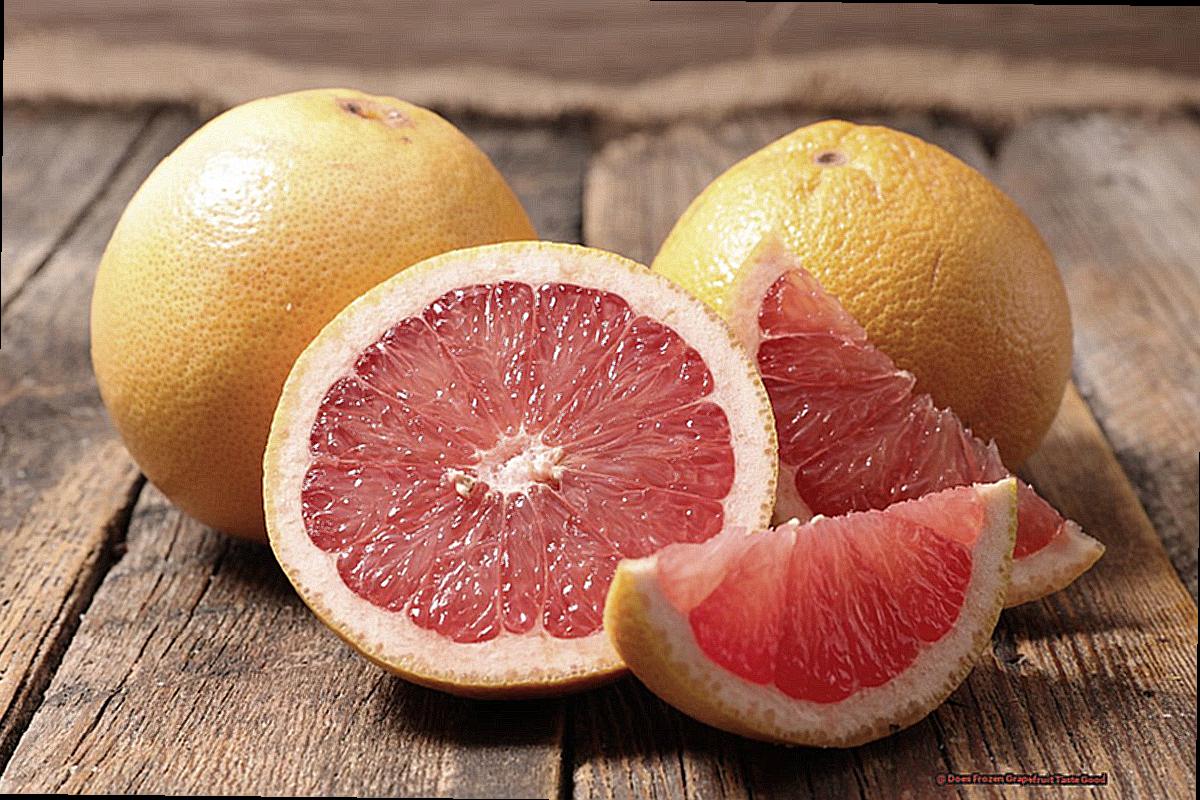Imagine a scorching summer day, with the sun beating down and sweat dripping from your brow. You’re in desperate need of something refreshing to cool you down. In a moment of inspiration, you remember the bag of frozen grapefruit sitting in your freezer. Could this be the perfect solution to your thirst?
As you take your first bite, the tangy yet sweet taste bursts onto your tongue, sending shivers of delight down your spine. It’s like a sorbet, but without any guilt. The cold temperature intensifies the tartness of the grapefruit, creating an explosion of flavor in every bite.
But let’s back up for a second – frozen grapefruit? Yes, it may sound strange at first, but trust me when I say that this underrated fruit is a game-changer when it comes to taste. Still not convinced? Here are some key points to sway you:
- The texture of frozen grapefruit is unlike anything else – smooth and icy, yet bursting with juicy goodness.
- The cold temperature brings out the natural tanginess of the grapefruit, giving it an extra zing that will awaken your taste buds.
- Not only is it delicious, but frozen grapefruit also packs a nutritional punch. It’s loaded with vitamin C and antioxidants, making it a guilt-free treat option.
- And if that’s not enough to convince you, consider this: you can use frozen grapefruit as ice cubes in cocktails or smoothies for an added burst of flavor.
Trust me – your taste buds will thank you for introducing them to this refreshing and flavorful fruit.

Contents
- 1 Does Frozen Grapefruit Taste Good?
- 2 How to Freeze Grapefruit?
- 2.1 Step 1: Select ripe and juicy grapefruits
- 2.2 Step 2: Wash the grapefruits
- 2.3 Step 3: Peel and segment the grapefruits
- 2.4 Step 4: Arrange the grapefruit segments on a baking sheet
- 2.5 Step 5: Flash freeze the segments
- 2.6 Step 6: Transfer the frozen grapefruit segments to airtight containers
- 2.7 Step 7: Label and date the containers
- 2.8 Step 8: Store the containers in the freezer
- 3 Conclusion
Does Frozen Grapefruit Taste Good?
Indeed, you are able to freeze grapefruits, and they freeze rather well. Grapefruit is a sweet, somewhat tart citrus fruit with good vitamin C and water content. Grapefruit can be frozen up to 12 months without losing its flavor, according to a Tasting Table article. However, thawed grapefruit sections become soggy that they may not be the best choice for a fruit salad or topping fresh greens. Frozen grapefruit can be added to smoothies for color and flavor. The juice is also used in pies and cocktails.
And as for the taste of frozen grapefruit, that is subjective. However, freezing grapefruit can digest some of the cell walls in the juice and turn the juice less flavorful and bitter. Also when thawed, grapefruit juice may be more watery, thin and less fruity compared to fresh grapefruit juice.
To conclude, although frozen grapefruit could be utilized in numerous recipes, it’s not necessarily the ideal option for those that love fresh grapefruit.
How to Freeze Grapefruit?
Step 1: Select ripe and juicy grapefruits
In order to guarantee the deliciousness of your frozen grapefruits, it’s crucial to choose ripe and juicy grapefruits. Here are some indicators to keep in mind when selecting grapefruits:
- Color: A ripe grapefruit will boast a vibrant, consistent color without any brown or green spots. While different grapefruit varieties may have varying hues, they should all be uniform and devoid of any imperfections.
- Texture: The ideal texture for a ripe grapefruit is firm with a slight softness when pressed. It should not have any mushy or shriveled areas.
- Weight: Due to their high water content, ripe grapefruits will feel heavier than their size suggests. This is a sign that the fruit is succulent and ready to be enjoyed.
- Aroma: The stem end of a ripe grapefruit will emit a sweet, strong fragrance. This is an indication that the fruit is fresh and perfect for consumption.
- Taste: Before freezing your grapefruits, it is recommended to taste one first to ensure it isn’t too sour or bitter. Each type of grapefruit has its own unique balance of sweetness and tartness, so choose one that satisfies your taste buds.
- Storage: Proper storage is crucial in maintaining the quality of your grapefruits. Keep them in a cool, dry place away from direct sunlight. For longer storage, refrigerate them, where they can last for two to three weeks.
- Separation: Grapefruits emit a gas that can accelerate ripening in other fruits, so it’s best to store them separately from other fruits.
If you observe any changes in color, overly soft or shriveled skin, unpleasant odor, or off taste in your grapefruit, it may have spoiled and should not be consumed.

Step 2: Wash the grapefruits
- Step 1: Wash the grapefruits properly before freezing. This ensures optimal taste and freshness when you’re ready to enjoy them.
- Step 2: Start by rinsing the grapefruits under cold water, removing any dirt or debris with a vegetable brush. This step is crucial as it helps to remove any harmful bacteria or pesticides that may be present on the skin.
- Step 3: For an even deeper clean, consider soaking the grapefruits in a mixture of vinegar or produce wash. This will help to eliminate any remaining dirt or bacteria on the surface.
- Step 4: Once you have thoroughly washed the grapefruits, make sure to dry them completely before peeling and segmenting. This is important as excess water can cause freezer burn and affect the taste and texture of the fruit.
- Step 5: Now, you’re ready to freeze your grapefruits. Simply peel and segment them, removing any white pith, and place them in an airtight container or freezer-safe bag.
- Pro tip: To add even more flavor to your frozen grapefruits, try sprinkling them with a bit of sugar or honey before freezing. This will help to enhance their natural sweetness and make for a delicious snack or addition to your favorite recipes.
By following these simple steps, you can ensure that your grapefruits are properly washed and prepared for freezing, resulting in a tasty and nutritious treat whenever you need it.
Step 3: Peel and segment the grapefruits
Peeling and segmenting a grapefruit can be done in various ways, but the “supreme” technique is considered the most efficient and simplest method. This technique involves removing the outer peel and membranes to get skin-free segments, leaving behind the bitter pith. Here’s how to do it:
- Start by slicing off the top and bottom of the grapefruit with a sharp knife.
- Stand the grapefruit on one flat end and carefully cut down the sides, following the fruit’s curve, to remove both the peel and white pith.
- Once all the peel is removed, you should be left with a circular shape containing only the juicy flesh.
- Hold the grapefruit over a bowl, then use a sharp paring knife to cut along each membrane, releasing the segments into the bowl.
- Repeat this process until all segments are removed from the grapefruit.
- If desired, you can also remove the pith before segmenting by gently peeling it away with your fingers or a paring knife. However, keep in mind that the pith is safe to eat and contains beneficial nutrients, so it’s up to personal preference whether or not to remove it.
Once you have your skin-free grapefruit segments, you can enjoy them as a healthy snack or use them in various recipes such as salads or appetizers. Don’t throw away the leftover grapefruit peel – it contains flavorful oils that can be used in infused water or candied peels.
Step 4: Arrange the grapefruit segments on a baking sheet
When it comes to freezing grapefruit segments, proper arrangement on a baking sheet is crucial for achieving optimal taste and texture. By following these simple steps, you can ensure that your frozen grapefruit segments retain their delicious flavor and texture when thawed.
Prepare the grapefruit segments
Before arranging the grapefruit segments on a baking sheet, it is important to properly prepare them. This involves removing the outer peel and membranes to obtain skin-free segments, leaving behind the bitter pith. You can use the “supreme” technique mentioned previously to achieve this.
Lay out a baking sheet
Select a large enough baking sheet that can hold all of your grapefruit segments without them touching each other. To prevent sticking, line the sheet with parchment paper.
Arrange the segments in a single layer
Lay out the grapefruit segments in a single layer on the prepared baking sheet. Be sure to leave enough space between each segment to prevent them from sticking together when frozen.
Place in the freezer
Once all the segments are arranged on the baking sheet, place it in the freezer. It is essential to freeze them in a single layer before storing them together to avoid clumping.
Store in an airtight container
After several hours of freezing, transfer the grapefruit segments into an airtight container for long-term storage. Remember to label the container with the date it was frozen.
Using this method of arranging grapefruit segments on a baking sheet before freezing ensures that they do not stick together and maintain their individual shape and texture when thawed. This way, you can enjoy delicious and juicy grapefruit all year round without any hassle.
To achieve this technique, it’s vital to keep in mind that proper arrangement on a baking sheet is essential for optimal taste and texture when it comes to freezing grapefruit segments.
Step 5: Flash freeze the segments
Grapefruit segments, when frozen, can undergo changes in their taste and texture, as a result of alterations in sugar and acid concentrations and the development of ice crystals.
Depending on one’s personal taste and proper preparation methods, some people may find frozen grapefruit to be either too overpowering or too mushy, while others may appreciate its zesty flavor and delicate consistency.
To preserve the grapefruit’s natural flavor and texture, it is crucial to flash freeze the segments before storing them. This process involves quickly freezing the segments at a very low temperature. It helps to lock in the grapefruit’s freshness and prevents the formation of large ice crystals that could alter its original taste and texture.
Additionally, when preparing frozen grapefruit, it is important to consider one’s individual preferences. Some may prefer a more intense flavor, while others may enjoy a softer texture. Therefore, proper preparation techniques, such as adjusting sugar and acid levels, can enhance the overall taste and consistency of frozen grapefruit.
Furthermore, it is essential to note that frozen grapefruit can provide a refreshing treat during hot summer days. Its tangy taste and softer texture make it a perfect choice for a cool and healthy snack. Additionally, incorporating frozen grapefruit into recipes can add a unique twist to traditional dishes, providing a burst of flavor and creativity.
Overall, frozen grapefruit offers a versatile and convenient option for preserving this delicious fruit. With proper preparation techniques and individual preferences in mind, it is possible to achieve a perfect balance of taste and texture in frozen grapefruit.
Step 6: Transfer the frozen grapefruit segments to airtight containers
When it comes to frozen grapefruit segments, one crucial step for maintaining their taste and safety is transferring them to airtight containers. This simple action not only prevents bacterial growth but also helps preserve their flavor and texture. In addition, it reduces the risk of foodborne illnesses, making it an essential step for any grapefruit lover.
But why exactly is this step so important? Well, first and foremost, transferring the frozen grapefruit segments to airtight containers helps prevent bacterial growth. As we all know, bacteria thrive in warm and moist environments, making your freezer the perfect breeding ground if you leave your grapefruit segments exposed. By sealing them in an airtight container, you create a barrier against potential bacteria, ensuring that your grapefruit remains safe to eat.
But that’s not all. Along with preventing bacterial growth, transferring the grapefruit segments also helps preserve their flavor and texture. When exposed to air, frozen fruits can become freezer burnt, resulting in a loss of flavor and texture. By storing them in an airtight container, you protect them from air exposure and maintain their delicious taste.
Lastly, this step also reduces the risk of foodborne illnesses. By sealing the grapefruit segments in an airtight container, you minimize the chances of cross-contamination from other foods in your freezer. This is especially important for those with allergies or weakened immune systems.
Step 7: Label and date the containers
When storing frozen grapefruit, it is essential to label and date the containers for various reasons, including food safety, quality control, and reducing food waste. By marking your containers with the date of freezing and the contents, you can easily track how long the grapefruit has been in the freezer and consume it within the recommended timeframe.
This simple step helps prevent potential foodborne illnesses or spoilage. Additionally, labeling assists in reducing food waste by reminding you to use the grapefruit before it reaches its expiration date. Moreover, by labeling your containers, you can avoid confusion and ensure that you use the correct type of grapefruit when needed.
An anecdote from my personal experience: My mom always stores frozen fruits in unlabeled containers, and it often led to confusion when trying to find a specific type. One time, we accidentally used cherries instead of blueberries for our smoothies because of this confusion. It was not only disappointing but also a waste of food. After that incident, we made sure to label and date all our containers to avoid any further mix-ups.
Some strategies you can use to ensure proper labeling and dating include using descriptive names for your containers, such as “frozen grapefruit chunks” or “grapefruit puree.”
In short, taking a few extra seconds to label and date your containers can save you from potential food safety issues, prevent confusion, and reduce food waste.
Step 8: Store the containers in the freezer
Frozen grapefruit can be stored in the freezer for up to 12 months before it begins to lose its delicious taste and flavor. However, it is recommended to consume frozen grapefruit within 6 months of freezing to maintain its optimum taste and flavor.
Factors such as the type and quality of grapefruit, freezer temperature, and storage conditions can all impact the storage time of frozen grapefruit. To ensure the best quality, it is crucial to properly seal and store the fruit in air-tight containers to prevent freezer burn and loss of flavor.
While frozen grapefruit may slightly lose some of its taste and flavor over time, it is still safe to eat beyond the recommended storage time. However, its texture and juiciness may be altered, making it more suitable for cooking or blending rather than eating raw.
It is essential to note that frozen grapefruit may also lose some of its nutritional value over time. Therefore, consuming fresh grapefruit whenever possible is highly recommended. To determine if frozen grapefruit is still safe to eat, check for any changes in color or texture. If you notice any signs of spoilage, such as mold or freezer burn, it is best to discard the fruit.
When thawing frozen grapefruit, it is important to do so in the refrigerator overnight instead of at room temperature. This will help preserve its taste and texture.
While frozen grapefruit may not have the same taste and flavor as fresh fruit, proper storage and consumption within a reasonable amount of time can still provide a convenient and delectable option. Remember to label and date your containers when storing frozen grapefruit to ensure food safety, quality control, and reduce food waste.
Conclusion
In conclusion, frozen grapefruit is a refreshing and delectable treat that is perfect for beating the heat. Its tangy yet sweet flavor and unique texture make it a game-changer for satisfying thirst and cravings. But don’t just take our word for it – try it out for yourself.
Not only does frozen grapefruit taste amazing, but it also packs a nutritional punch with its high levels of vitamin C and antioxidants. And the best part? It’s guilt-free. So indulge in this frozen delight without any worries.
To achieve the best taste and texture, be sure to select ripe and juicy grapefruits, properly wash them, peel and segment them using the “supreme” technique, arrange them in a single layer on a baking sheet, and flash freeze them before storing in an airtight container.




